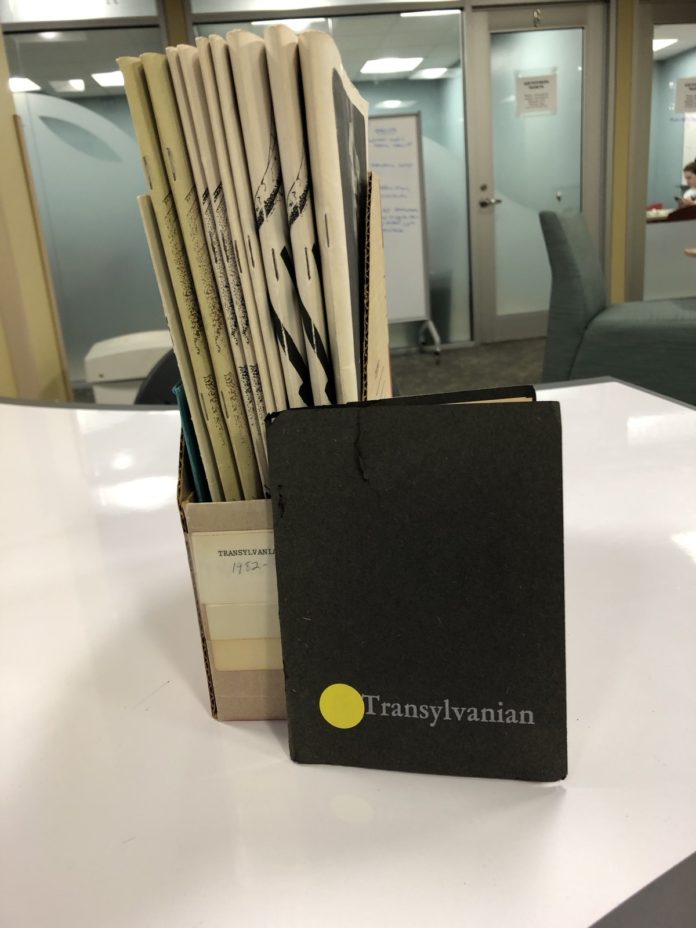Welcome to Lit Review, where columnist Dominiq Wilson will take apart a series of chapbooks to figure out what works and what doesn’t for the modern reader of poetry.
In celebration of The Transylvanian, the Transy literary magazine, opening up their submissions for this year’s legacy-themed publication, I’ve decided to review some of the older versions of our literary magazine. It was brought to my attention by Rambler copy editor Makayla Dublin that the construction of these magazines was very similar to the construction of early chapbooks, so I decided to give it a go.
The oldest copy of The Transylvanian I could access was printed in the spring of 1979, and if I could visualize a 15th-century chapbook, this is it. The cover is made of black construction paper, and the title of the literary magazine was printed in a silvery-white color at the bottom of the page. Thankfully, the spine was stapled, but the staples had begun to tear through the construction paper, so I was very careful when flipping through the pages of the book. While I read through, I was surprised to see that the construction of the pages wasn’t properly ordered, which put an extra poem and print near the end of the book. Luckily, for me, I flipped through the whole thing. If you get the chance to check out this chapbook, I suggest you do the same, but handle the book with care as it’s gone through some wear and tear.
Inside were mostly poems as well as smaller drawings. There wasn’t an explicitly-stated theme to connect the works in this collection, but I don’t think its absence dampens my opinion of the works within the book. To be quite honest, I don’t think that any of the chapbooks I’ve read so far have explicitly stated the theme of the collection. The absence of the theme adds a curious mystery to them. While an explicit theme would be helpful, I do think that personal interpretation helps the reader connect to the writing more easily. Without an explicit theme, you’re not really sure what you’re going to read. It’s like an interesting game of hide-and-seek, but you’re not really sure what you’re looking for.
All of this rambling aside, I did find that all of the poetry in this collection did have a loose but present theme of loss. In some poems, like “now ago” by Fred Stocker and “Dolls” by Leslie Baldridge, the theme doesn’t show itself as well. There are others, like “A Poem For My Father” by Richard Taylor and “12-9-72” by Gracie Hale, that showcase the theme a bit more brightly than the others. I find that “A Woman’s Museum” by Chris Lawson showcases the theme semi-obviously but utilizes a metaphor to hide it.
“The woman finds a space,
lays a cloth and
prepares to sell.
She takes each jar and holds it
up to the sun, they glisten.
She takes a certain pride
in her stock.
These were her babies-to-be.
The older ones, the more expensive,
are the ones with names:
Sam, to have been like Dad.
Sweet Maybell, the blue-eyed promise.
Listen, this is not pickle she sells;
it is craft, fetal and embryonic.
It is her own tragedy:
jar upon jar,
capped and saved.”
This poem, to me, tells the story of a mother who has gone through many miscarriages. In an attempt to let go, she sells her memories in jars to anyone who will buy them. I marked this poem as one of my favorites in this collection, and the metaphor deserves the credit, really. Without it, I have no doubt this poem would’ve been bland.
The other poem that caught my eye was “Jeff Young at Registration” by Harvey O. Davis. Not only is this poem in the middle of the book, almost calling to be read first, but it’s also the only page with printed color. In red lettering is an explanatory note that describes the subject of the poem: Jeff Young. To be honest, there isn’t much interpretation I can do with this poem, but it’s still very impactful without it.
As always, there are poems that I couldn’t interpret as easily, but I found that the two I’d gotten stumped on weren’t complex in nature. However, they didn’t connect to the theme as well as the rest of the poems. “Taking a Bath” by Chris Lawson is the most confusing of them all.
“Let me explain the bathroom:
wooden walls and a dangling light, a tin cabinet
full of washcloths, old towels.
A cake of soap.
A tub on four white legs.
I mash the rubber stopper into its plug.
I turn the cold water on.
The hot.
I take off my trousers, my shirt, each sock,
the shorts.
The water is tepid and ready.
So last, I unpeel my skin,
undo my bones and leave them neatly stacked.
Wrap what’s left in a clean tissue.
I am taking a bath
and when I go in
I go in for keeps.”
All I could note about this poem is that it gets a bit morbid and mysterious at the end. What it is referencing is a mystery to me, but I thoroughly enjoy this poem as well.
Another strange poem in this collection is “Unicorn” by Gracie Hale, which shares the spread with the previously mentioned poem. Now, I’m being honest when I say that I’m completely baffled by this poem, as it seems to appreciate and depreciate this mythological equestrian creature, but it piques my interest in a more jovial way than “Taking a Bath” does. I couldn’t resist smiling as I read.
I really enjoyed the experience of reading the first accessible print of The Transylvanian, and I’ll definitely read the other three that resemble the chapbook construction. If you’d like to read through these books, they are on the lower level of the library in the back periodicals section.
If having your work published is more your speed, I highly suggest that you submit to The Transylvanian that will be printed this academic year. The theme is ‘Legacy,’ and submissions will be closing on March 8th. You can submit visual art, prose, poetry, photography, and a script if you want too! Please send your submissions to transylvanianlitmag@gmail.com with your submissions! —DW




